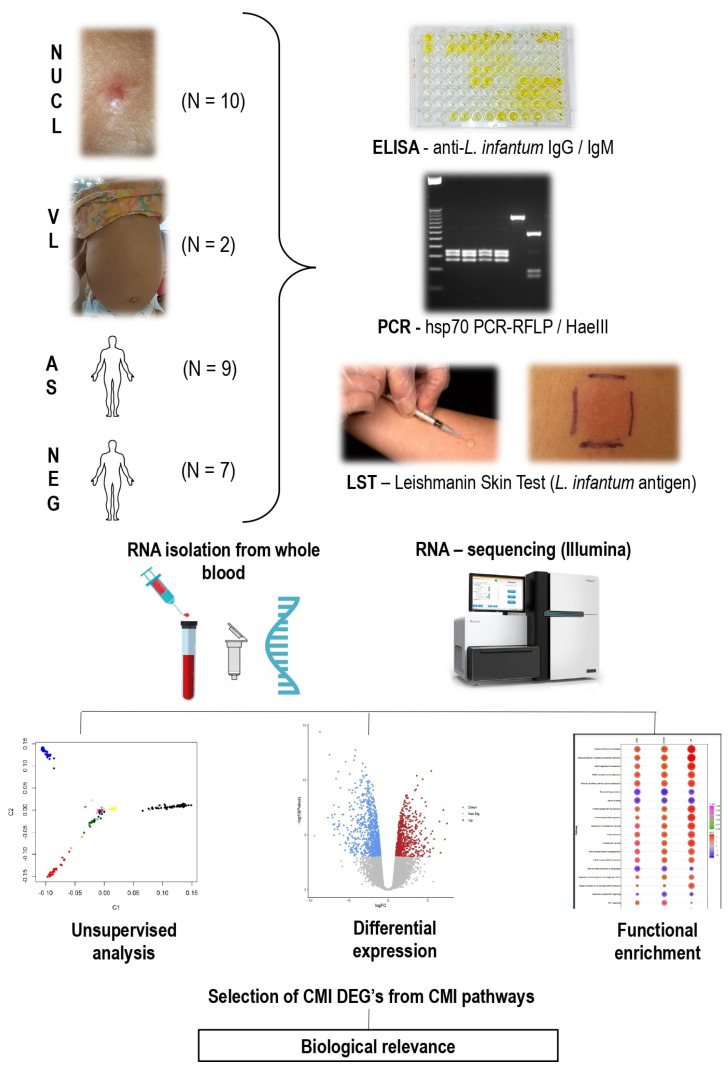Molecular Insights into Cell-Mediated Immunity in Atypical Non-Ulcerated Cutaneous Leishmaniasis.
Leishmania (Leishmania) infantum chagasi infections range from asymptomatic (AS) to severe visceral leishmaniasis (VL). One of the manifestations is an atypical non-ulcerated cutaneous leishmaniasis (NUCL), which occurs in some locations of Central America with few cases of VL. We conducted a transcriptomic analysis of cell-mediated immunity (CMI) on blood samples from NUCL, AS, VL patients from Amapala, Honduras, and healthy controls. RNA-seq revealed a similar perturbation of gene expression in NUCL and AS. Eight gene signatures of CMI were found in NUCL involved in CD8+ T lymphocyte infiltration, reactive oxygen species generation, PD-1 receptor ligand, inflammasome assembly, chemotaxis, complement receptor and suppressor immune cell infiltration. NUCL was distinguished from VL by its up-regulation of differently expressed genes (DEGs) related to T lymphocyte exhaustion, adhesion and transmigration of leukocytes, and down-regulation of oxidative stress genes. In contrast, VL exhibited up-regulated DEGs involved in antigen cross-presentation, and similar to VL from Brazil, down-regulated DEGs involved in innate immunity. Corroborating the transcriptome findings, both the Leishmanin skin test, and the immunopathology of NUCL skin lesion defined NUCL as a proinflammatory condition, intermediate between the AS and VL clinical outcomes. That condition may be the underlying element for the benign nature of the NUCL.
Authors
Batista LFS, Sandoval Pacheco CM, Flores GVA, Ferreira FM, et al.
External link
Publication Year
Publication Journal
Associeted Project
Systems Immunology of Human Diseases
Lista de serviços
-
Gene regulatory and signaling networks exhibit distinct topological distributions of motifs.Gene regulatory and signaling networks exhibit distinct topological distributions of motifs.
-
Gene signatures of autopsy lungs from obese patients with COVID-19.Gene signatures of autopsy lungs from obese patients with COVID-19.
-
Network Medicine: Methods and ApplicationsNetwork Medicine: Methods and Applications
-
ACE2 Expression Is Increased in the Lungs of Patients With Comorbidities Associated With Severe COVID-19.ACE2 Expression Is Increased in the Lungs of Patients With Comorbidities Associated With Severe COVID-19.
-
Drug repositioning for psychiatric and neurological disorders through a network medicine approach.Drug repositioning for psychiatric and neurological disorders through a network medicine approach.
-
Linking proteomic alterations in schizophrenia hippocampus to NMDAr hypofunction in human neurons and oligodendrocytes.Linking proteomic alterations in schizophrenia hippocampus to NMDAr hypofunction in human neurons and oligodendrocytes.
-
In-depth analysis of laboratory parameters reveals the interplay between sex, age, and systemic inflammation in individuals with COVID-19.In-depth analysis of laboratory parameters reveals the interplay between sex, age, and systemic inflammation in individuals with COVID-19.
-
The evolution of knowledge on genes associated with human diseasesThe evolution of knowledge on genes associated with human diseases
-
Network vaccinology.Network vaccinology.
-
Pyruvate kinase M2 mediates IL-17 signaling in keratinocytes driving psoriatic skin inflammationPyruvate kinase M2 mediates IL-17 signaling in keratinocytes driving psoriatic skin inflammation
-
Transcriptome analysis of six tissues obtained post-mortem from sepsis patientsTranscriptome analysis of six tissues obtained post-mortem from sepsis patients
-
Gene Signatures of Symptomatic and Asymptomatic Clinical-Immunological Profiles of Human Infection by Leishmania (L.) chagasi in Amazonian BrazilGene Signatures of Symptomatic and Asymptomatic Clinical-Immunological Profiles of Human Infection by Leishmania (L.) chagasi in Amazonian Brazil
-
In vitro morphological profiling of T cells predicts clinical response to natalizumab therapy in patients with multiple sclerosis.In vitro morphological profiling of T cells predicts clinical response to natalizumab therapy in patients with multiple sclerosis.
-
Integrative immunology identified interferome signatures in uveitis and systemic disease-associated uveitis.Integrative immunology identified interferome signatures in uveitis and systemic disease-associated uveitis.
-
Gene regulatory networks analysis for the discovery of prognostic genes in gliomas.Gene regulatory networks analysis for the discovery of prognostic genes in gliomas.
-
Revealing shared molecular drivers of brain metastases from distinct primary tumors.Revealing shared molecular drivers of brain metastases from distinct primary tumors.

